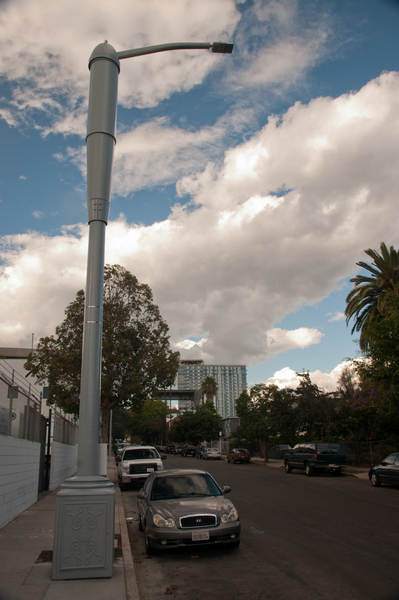-
Delivers enhanced and more reliable wireless data broadband coverage to businesses and citizens in one of the largest cities in the world.
-
100 LED light poles to be fitted with new small cell technology from Ericsson that will host mobile network operator equipment.
-
Leading-edge energy efficiency LED street lighting to help LA to meet sustainability goals while improving mobile network performance and reducing urban clutter.
Royal Philips, the global leader in lighting, announced that the City of Los Angeles (LA) will be the first city in the world to deploy 100 Philips SmartPoles – connected LED street lighting that includes fully integrated 4G LTE wireless telecommunications technology by Ericsson. The collaboration between Philips and Ericsson delivers on the latest Internet of Things (IoT) innovation and provides a double benefit to LA citizens: high quality, public lighting that is energy efficient as well as improved network performance in dense urban areas.
 |
|
A hundred Philips SmartPoles integrated with 4G LTE wireless telecommunications technology from Ericcson have been deployed in LA. (All photos courtesy of Philips) |
"The analog light pole has evolved right here in Los Angeles,” said Mayor Eric Garcetti. “L.A. is a world leader in LED street lights and has more poles than any other city in America. We are now taking advantage of previously untapped real estate to give our streets better broadband connectivity and future-ready infrastructure, while generating revenue for the city. This project shows what smart infrastructure can do for Los Angeles: create jobs, save tax payer dollars, and improve our environment."
This project expands on Philips’ existing relationship with the City of LA. Earlier this year, LA became the first city in North America to monitor and control its street lighting through Philips CityTouch, an advanced Philips streetlight asset management system that uses mobile and cloud-based technologies. Better lit streets contribute to safer streets, less accidents and deter crime while connected management of street lighting reduces further the amount of energy used and simplifies maintenance.
Amy Huntington, President of Philips Lighting Americas said: “The Philips SmartPole technology proves its role as the backbone in an outdoor Internet of Things platform capable of delivering new services and value. This is also fully aligned with many of Mayor Garcetti’s key priorities and outcomes by taking LED street lighting and turning it into a services hub that can adapt to the changing needs of a particular neighborhood over time.”
 |
|
A Philips SmartPoles integrated with 4G LTE wireless telecommunications technology installed in a LA neighborhood. |
With cellular data traffic expected to grow 9 times by 2020, according to the Ericsson Mobility Report, and current telecoms infrastructure struggling to respond to this demand, Philips SmartPoles are enabling seamless mobile wireless 4G/LTE connectivity, with the small cell technology from Ericsson housed in the poles to enable increased data capacity in the telecoms network. Philips SmartPoles were specifically designed and tested to accept FCC licensed wireless mobile network operator equipment. This enables an alternative deployment methodology for 4G LTE broadband services which will connect each pole through a fiber link to its core network.
Arun Bansal, Senior Vice President and Head of Business Unit Radio, Ericsson, said: “LA will be a role model for other smart cities that place sustainability and connectivity high on their agenda. As citizens, businesses and industries transform through mobility, cities have an increasingly important role to play as eco-system partners enabling the next wave of innovations that will bring us to 5G in 2020. Innovative solutions like Philips SmartPoles and Ericsson Zero Site that efficiently improve the performance of mobile networks will be necessary to address the growing demand from both smartphone users and the Internet of Things.”
For mobile network operators this innovation offers new possibilities to find the right site location. It also helps scale mobile wireless 4G/LTE infrastructure deployment beyond traditional sites. As a result operators can improve data coverage and capacity for citizens so there are no more signal dropouts.













